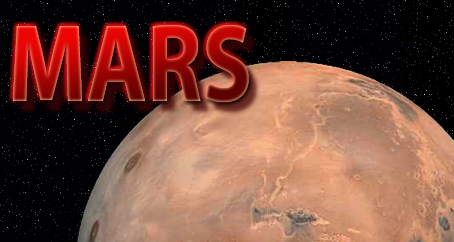Missions to Mars: Part 2
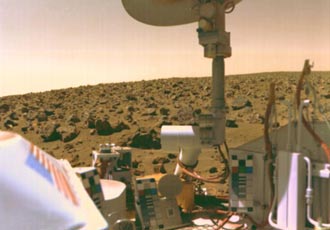
During the 1960s and 1970s, America and Russia sent of number of spacecrafts to Mars. Despite several failures, the first spacecrafts that did reach their destination revealed Mars to be a geologically dead planet with a cratered surface a lot like the surface of the Moon. This disappointed scientists who were hoping, but not really expecting, to see evidence of canals on Mars built by ancient civilisations. These canals or channels, thought to have been used to transport water from the wetter poles to drier regions on Mars, had been observed by several astronomers in the nineteenth century, or at least they claimed to have observed them. Although no canals have ever been found, Martian orbiters and landers went on to reveal ancient volcanoes on the planet, dried out river beds (confirming the presence of water at some point) and a massive chasm running half-way across the surface of the planet. During the 1980s and early 1990s, America turned a lot of its attention to the Space Shuttle program, and Russia virtually gave up on Mars. There were a few failed attempts to get there (Phobos 1 and 2 in 1988 and Mars Orbiter in 1992), but apart from those, the Red Planet was left alone.
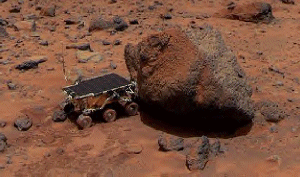
A renewed interest in Mars began in 1996 with the launch of two very important spacecrafts. Mars Global Surveyor and Mars Pathfinder were the first of NASA's cheap and cheerful spacecrafts, costing millions, rather than billions, of dollars. Mars Global Surveyor was an orbiter and Pathfinder was a lander. Mars Global Surveyor set off on its journey on November 7th 1996 and reached its destination on September 11th 1997. It entered into an orbit of the planet and began sending back data and images of Mars shortly afterwards. Pathfinder lifted off on December 4th 1996 and landed on the planet on July 4th 1997. Maybe it knew a short-cut there seeing as it set off after Global Surveyor but got there first! Pathfinder used parachutes to slow its descent to the planet's surface and giant airbags to cushion its landing on Mars, and after deflating these airbags, released a rover which went by the name Sojourner (pictured right having a chat with a rock called Yogi). The landing site was named the Carl Sagan Memorial Station. The Pathfinder lander and Sojourner rover spent three happy months taking pictures and probing rocks, lasting much longer than scientists expected them to (they were expected to last about a week, perhaps a month if lucky). The Sojourner rover was controlled from Earth, so it was essentially a very expensive remote control toy. However, commands from Earth took fifteen minutes to reach Mars and it didn't move very fast either, so it probably wasn't that much fun to play with. Most of the images taken during the Pathfinder mission came from the lander, although a smaller number were taken by the rover. After 83 Martian days (sols), communications with Pathfinder stopped, probably due to the intense cold on Mars at night. Once communications stopped, Sojourner was programmed to return to the lander and circle it, just in case communications could be resumed. This is so Sojourner didn't go wandering off. However, communications never resumed, and for all we know, Sojourner could still be circling the lander now!
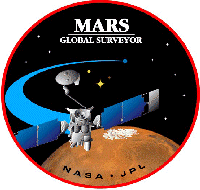
NASA made their last attempt to contact Pathfinder on 10th March 1998.
Despite Pathfinder's end, Mars Global Surveyor was still going strong in orbit of the planet, sending back a huge amount of data and
images of the red world. Its mission was first extended on February 1st 2001, again on February 1st 2002 and for a final time on
October 1st 2006. During that time, it has managed to observe more recent visitors on the surface of Mars and other satellites in
orbit of the planet. On November 2nd 2006, communications with Mars Global Surveyor stopped. This was
due to being given an incorrect computer command which caused it to position
itself incorrectly. A radiator which keeps the batteries
cool was exposed to the Sun so one of the batteries overheated. The solar panels which provided power to the batteries were also
positioned incorrectly so they couldn't receive energy from the
Sun and charge up the batteries. Despite a weak signal from Mars
Global Surveyor being received on November 5th 2006, attempts to find it were in vain and on January 28th 2007, NASA officially
gave up looking for it. However, like Pathfinder, Mars Global Surveyor far exceeded its expected lifetime and holds the record
for the longest continuous Mars mission.
As well as Mars Global Surveyor and Mars Pathfinder in 1996, Russia attempted to go to Mars with its Mars 96 orbiter. Based on
technology used in the Phobos missions of 1988, Mars 96 failed to escape from
Earth's atmosphere and landed in the Pacific Ocean. This
wasn't the only failed mission to Mars of the late 1990s. Japan launched Nozomi on July 4th 1998 but it ran out of fuel before
reaching Mars, so was sent off to wander space for eternity, probably to look for somewhere to fill up. Launched on December 11th
1998, NASA's Mars Climate Orbiter, which should have orbited the planet and observed the planet's climate, instead fell into the
planet's atmosphere and is likely to have burnt up during its descent. This navigation mistake was caused by scientists getting
their units of measurement mixed up, using imperial units instead of metric! Mars Polar Lander also suffered an unfortunate end.
Launched on March 3rd 1999 and ready to land on December 3rd 1999, communications were suddenly lost as the craft began its descent
to the planet's surface. It is likely that the craft did land on Mars, but where about is a mystery. Mars Global Surveyor attempted
to find it, but gave up in the end and went back to looking at craters and other stuff instead.
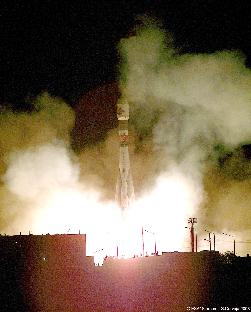
Since the start of the twenty first century, there have been several more missions to Mars. These have mostly been successful and some are still active now. One of the main reasons for visiting Mars is because it is thought that the planet may once have been like Earth. It is widely believed that Mars was once a wet planet with warmer climates and a thicker atmosphere. And, if Mars was once like Earth, then there's a possibility that it could have once supported life. Or, even better, could still support life! It is inevitable that people from Earth will one day set foot on Mars and there's a chance that those people are now alive on Earth! It has been almost forty years since anybody has been to the Moon, but plans are in progress to send people back there within the next fifteen years. So after returning to the Moon, Mars is logically the next place to visit. Spacecraft going to Mars look for signs of life, and something they want to find is water. Living beings on Earth can exist in extreme conditions, but water is seen as essential for all forms of life. The conditions on Mars are not as extreme as some places on Earth can be, so if there is water there, there should be no reason why there can't be life there too! Like Mars Global Surveyor, modern spacecraft are sent to observe Mars while orbiting the planet. Being able to see the planet in more detail than ever before, they can look for evidence of water in all four corners of the planet, not that Mars has corners. NASA's Mars Odyssey 2001 (named after the film, 2001: A Space Odyssey) was launched in 2001 and is currently orbiting the planet. It was joined in 2003 by Europe's Mars Express (pictured left just after lift-off) and in 2006 by NASA's Mars Reconnaissance Orbiter. Interestingly, some of the equipment on Mars Express came from Russia's failed Mars 96 mission so in a way that mission wasn't a complete waste! Mars Odyssey and Mars Express were used in late 2006 to try to spot Mars Global Surveyor when it lost its power and stopped communicating with Earth, but failed to find it. I'm sure it'll turn up one day. It's always in the last place you look!
The three orbiters are still spinning around Mars and keeping an eye on the planet. However, down
on Mars itself, three other spacecraft have been busily exploring the planet. There are two Mars Exploration Rovers, known as Spirit and Opportunity,
and a lander known as Phoenix. Like the Sojourner rover of the Pathfinder
mission, Spirit and Opportunity are remote-controlled rovers that drive around
the planet, take in the scenery and poke rocks. There should be a third rover
there, Beagle 2, which hitched a ride onboard Europe's Mars Express space craft
in 2003. As Beagle 2 dropped to the surface of Mars in December 2003, contact
with it was lost and its final landing place is not known. Spirit and
Opportunity however are two examples of spacecraft which have far exceeded their
expected life span. Spirit was launched on June 10th 2003 and Opportunity was
launched July 7th 2003. Both crafts reached their destination and landed safely
in January 2004 in completely different locations on the planet. They were
expected to last about 90 days, but have lasted much longer. The last contact
with Spirit was in March 2010, with the last attempt to contact it being in May
2011. Opportunity, however, is still active and now holds the record for the
longest period of activity of any spacecraft on the surface of Mars. Viking 1
was the previous holder, which managed 6 years and 116 days of activity. Of course,
its condition has deteriorated (it has to travel backwards and its arm that
picks up interesting rocks has faulty joints!), but it still continuse to send back useful and interesting information from the surface of Mars.
Neither have found any aliens though! The
newest addition to Mars was Phoenix. Phoenix was launched in August 2007 and reached Mars in May 2008, landing on the planet's surface
on May 25th. Phoenix landed near the northern polar region of Mars. As the main purpose of space exploration is to find life, Phoenix
landed in an area which scientists believe would be a likely place for life to exist. Although it is unlikely that water is present on
the surface of Mars, there are chances that it may be present below the surface. Phoenix's
aim was to detect evidence of water below
the surface, and it even took a bucket and spade to go digging! Well, something that can dig a few feet under the surface. Like Spirit
and Opportunity, Phoenix was only expected to last 90 days, but lasted over 130. Since it has landed in a region which gets extremely cold during Martian winter
(up to three feet of carbon dioxide ice can form there in winter), Phoenix
wasn't expected to last through the season and attempts to wake it up after a
period in "safe mode" were unsuccessful. This was to be expected as the craft
simply wasn't designed to cope with the extreme conditions. However, Phoenix was
a success. It did successfully find water on Mars! It is expected that future
missions will build on the discoveries made by Phoenix to learn more about Mars'
present water.
As well as going
to Mars with various bits of scientific equipment, Spirit, Opportunity and Phoenix also took DVDs with them! These DVDs contain various
messages from Earthlings to visitors to Mars (most likely to be human beings in years to come). They also feature examples of art and
literature - such as a radio broadcast of the H.G. Wells' story The War of the Worlds - and the names of millions of people from
Earth.
Who knows what future visitors/passing Martians will play the DVDs on seeing as no DVD player has been sent over yet!
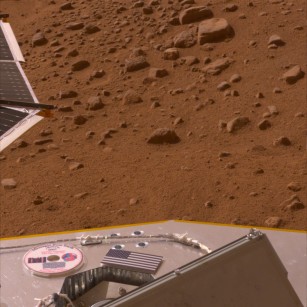
Even though there is plenty of activity taking place on Mars now, Mars had better get used to it because there
is more to come! Future rovers and landers include Mars Science Laboratory, Mars Sample Return Lander, Mars Scout 2, Mars Scout 3, Mars
Astrobiology Field Lab Rover, Mars Planetary Evolution and Meteorology Network and ExoMars. Like past and present missions, these landers
and rovers will analyse the surface of Mars, looking for signs of life and attempt to establish whether the planet could support
life in
the future. The ultimate aim is to put human beings on Mars. Human beings on Mars will need to survive there for several months, not days
like during past missions to the Moon. Martian air is poisonous to breathe, and all food and drink will have to be taken to the planet
from Earth. Including the journey time, a manned mission to Mars is likely to last for at least two years so scientists have to find
ways of ensuring that human beings can survive for that long away from
Earth. But, at least when they get to Mars, they'll have the
three DVDs on Spirit, Opportunity and Phoenix to watch. Shame that the crafts are hundreds of miles apart!
